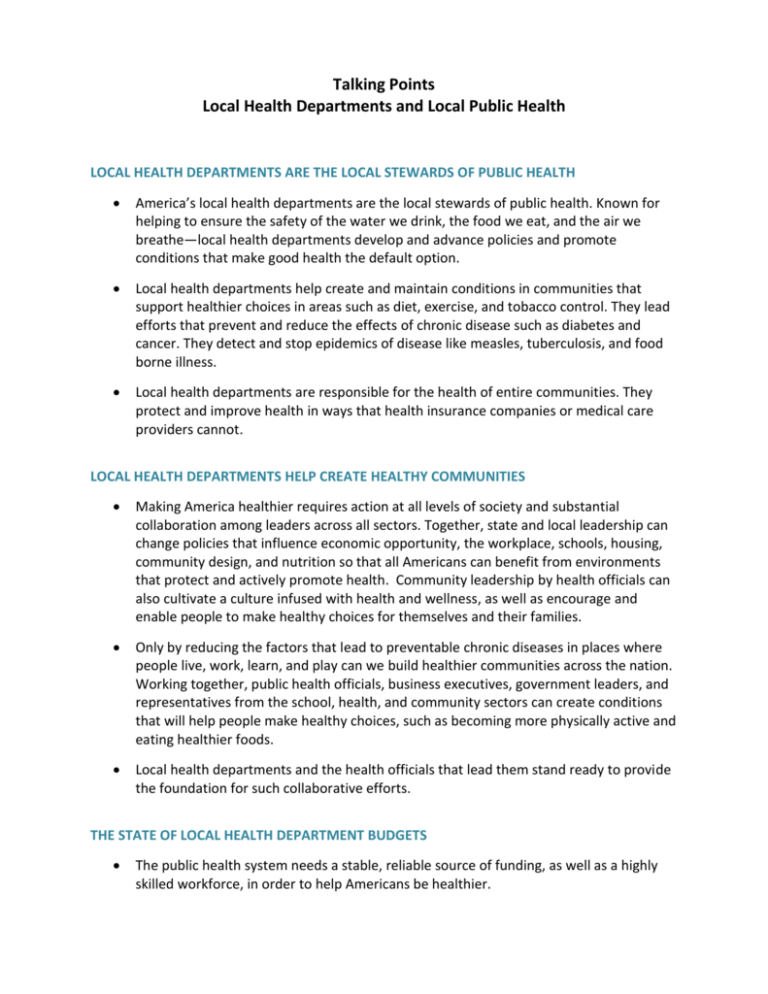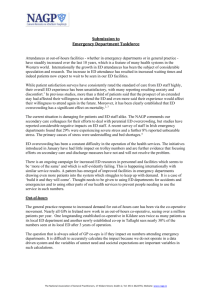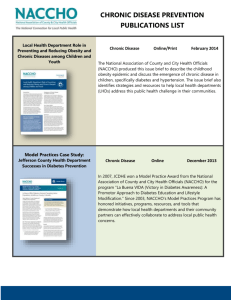Talking Points Local Health Departments and Local Public Health
advertisement

Talking Points Local Health Departments and Local Public Health LOCAL HEALTH DEPARTMENTS ARE THE LOCAL STEWARDS OF PUBLIC HEALTH America’s local health departments are the local stewards of public health. Known for helping to ensure the safety of the water we drink, the food we eat, and the air we breathe—local health departments develop and advance policies and promote conditions that make good health the default option. Local health departments help create and maintain conditions in communities that support healthier choices in areas such as diet, exercise, and tobacco control. They lead efforts that prevent and reduce the effects of chronic disease such as diabetes and cancer. They detect and stop epidemics of disease like measles, tuberculosis, and food borne illness. Local health departments are responsible for the health of entire communities. They protect and improve health in ways that health insurance companies or medical care providers cannot. LOCAL HEALTH DEPARTMENTS HELP CREATE HEALTHY COMMUNITIES Making America healthier requires action at all levels of society and substantial collaboration among leaders across all sectors. Together, state and local leadership can change policies that influence economic opportunity, the workplace, schools, housing, community design, and nutrition so that all Americans can benefit from environments that protect and actively promote health. Community leadership by health officials can also cultivate a culture infused with health and wellness, as well as encourage and enable people to make healthy choices for themselves and their families. Only by reducing the factors that lead to preventable chronic diseases in places where people live, work, learn, and play can we build healthier communities across the nation. Working together, public health officials, business executives, government leaders, and representatives from the school, health, and community sectors can create conditions that will help people make healthy choices, such as becoming more physically active and eating healthier foods. Local health departments and the health officials that lead them stand ready to provide the foundation for such collaborative efforts. THE STATE OF LOCAL HEALTH DEPARTMENT BUDGETS The public health system needs a stable, reliable source of funding, as well as a highly skilled workforce, in order to help Americans be healthier. Last year, the National Association of County and City Health Officials (NACCHO), surveyed a sample of local health departments nationwide to measure the impact of current economic conditions on local health department budgets, workforce, and programs. The report, released in May 2010, showed that the recession and budget cuts at the federal, state, and local levels have caused local health departments to reduce their workforce by 23,000 jobs, or 15 percent in the past two years. These cumulative reductions in staff are compromising local health departments’ ability to keep Americans healthy, respond to public health emergencies, and address the escalating burden of chronic disease. In [Name of Jurisdiction], we have faced the following cuts: MAKING AN INVESTMENT IN PUBLIC HEATLH The Patient Protection and Affordable Care Act (ACA), which expands insurance coverage to millions of Americans and creates the Prevention and Public Health Fund, is an unprecedented investment in public health. The Fund provides mandatory funding (not subject to the annual appropriations process) beginning with $500 million in FY 2010, escalating to $750 million in FY 2011, $1 billion in FY 2012, $1.25 billion in FY 2013, $1.5 billion in FY 2014, and $2 billion in FY 2015 and each fiscal year thereafter. The creation of the Fund is a major advancement of prevention and public health activities at the federal, state and local level. The U.S. Department of Health and Human Services estimates that approximately 33% of all deaths in the U.S. are attributable to just three modifiable health behaviors: smoking, physical inactivity, and poor eating habits. Despite the high rates of preventable death in the U.S., investment in prevention has been historically modest, accounting for only 4% of all health care expenditures. In 2008, Trust For America’s Health found that an investment of $10 per person per year in proven community-based programs to increase physical activity, improve nutrition, and prevent smoking and other tobacco use could save the country more than $16 billion annually within 5 years. This is a return of $5.60 for every $1 invested. Out of the $16 billion, Medicare could save more than $5 billion, Medicaid could save more than $1.9 billion, and private payers could save more than $9 billion. The majority of American workers have at least one chronic health condition. As a result, researchers estimate that 75% of all healthcare costs directly stem from preventable chronic conditions such as type 2 diabetes, hypertension, and obesity. For employers, these preventable health problems result in substantial direct and indirect costs including increased disability, lost productivity, absenteeism, and increased turnover. Thank you for your interest in public health. We look forward to working with you to make sure that the public’s health is protected in our community.









